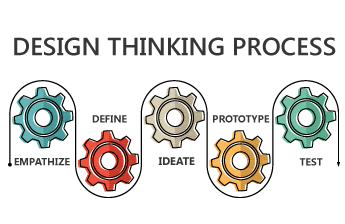With applications ranging from organizational design to product development, a design-thinking approach lies at the root of some of the most successful products and platforms. Uber, Apple, and philanthropic organizations +Acumen and New York Cares have used design thinking to create intuitive, enjoyable user experiences for a variety of products and services.
Design thinking is a 5- phase approach that can vary from team to team, organization to organization, but the core mindset is the same—understand the people and problem, and take action. If you are not familiar with design thinking, watch our informative design thinking video.
One such risk arises when the practitioner or team doesn’t understand the use—or the limitations—of design thinking. The best example is the semantic dispute over what exactly design thinking is. Different sources provide countless contradictory descriptions and steps, and this lack of clarity leaves the process open to interpretation, thus introducing bias, subjectivity, and falsifications.
Another liability lies in human nature: specifically, the ego. Some would-be practitioners are motivated by the desire to be seen as creative and forward thinking—so they reach for design thinking. But applying the process won’t transform you into a designer overnight. It may even do a disservice to your team—and your clients—by conflating the framework of design thinking with the practice of design.
A third risk lies in the larger context of the organization using design thinking. Even the most faithful implementation will not confer value without corporate compatibility in the form of leadership support of design thinking, willingness to support new ideas, and the freedom for all stakeholders to speak openly during the process.
L&D professionals, might assume that they can mitigate these risks through, well, more L&D. Surely a practitioner trained in design thinking can be trusted to “do it right.”
Not so fast. Design thinking courses vary widely in quality, and some perpetuate inconsistent definitions of the process and its applications. Some courses provide learners with a perfectly competent theoretical approach to design thinking, but simply undertaking a training course is not enough. Design thinking requires application and practice to support training in theory and philosophy. A new practitioner needs a community of practice in which to question and critique, and grow in their design-thinking practice. Earning a certificate is not enough.
The best way to help L&D professionals harness the potential value of design thinking is to learn about it, question it, and then apply it. As it stands now, the value of design thinking is subjective to the practitioner’s understanding and potential application of some discrete activities during a workshop. However, the value should increase as the team adopts a mindset that is focused on the learner and understands that design thinking simply is one tool to embrace that mindset.
Given all of these caveats, why use design thinking? The short and honest answer is “sometimes.” Training problems that are candidates for the design-thinking approach are characterized by a lack of attention and focus on the learner.
Consider this scenario: A client “orders” a training program in time for a product launch or a cohort of new hires instead of asking what learners might need. The impulse is often to jump in and begin designing; however, L&D professionals add more value when building time for learner empathy into the process. Though the Empathize phase can be the most fluid and time consuming—not to mention humbling—step in the process, conversations with learners are worth the investment. Their findings can help strengthen training programs in three key ways:
Empathizing helps us create authentic and accessible learning. Against our better judgment, L&D professionals churn out too many deliverables that resemble outdated textbooks, complete with tiny font, bulleted lists, and the occasional image. When the target audience consists of learners who perform hands-on, interpersonal, or less-specialized tasks, reading about skills may not serve them.
Empathizing helps us to show respect for learners’ time. Learners’ needs differ based upon job role, readiness, tenure, and even region. Veterans and new hires will express vastly different performance support needs and should not be herded onto a single, generic learning path. Once learners have achieved competency, training should demonstrate respect for their needs by taking them away from their jobs only minimally. Certain learners, such as sales staff, are particularly sensitive to being taken out of the workstream, as time away from work directly translates to lost income.
Empathizing sometimes means that advocating against an unnecessary deliverable. A commitment to both clients and learners means we are obligated to advise against “solutions” unlikely to benefit either. We’re not talking ourselves out of a job: Showing respect for the client’s investment and the learner’s time builds both parties’ trust in the work we do.
As L&D professionals, we like to believe we have the answers—or at least a solid hypothesis about what the answers might be. Design thinking invites variability and uncertainty into a process we sometimes wish to contain and control. However, our value as L&D professionals increases as we adopt a mindset that focuses on the ever-evolving learner. Design thinking is one of many tools that reminds us to maintain this focus. As with any craft, the expertise lies in knowing when—and how—to use it.
